ILCA / Laser Sailing Speed - Running With Sir Ben Ainslie
Book Extract
MEDIUM WINDS
Sailing a Laser fast downwind is an art. There is no right or wrong way to sail downwind and many different techniques seem to be as fast as each other.
There is no doubt that being fast downwind is essential for any serious racer. Often people overlook the gains which can be made and they are often greater than the gains you can make upwind. I would largely attribute my success in Lasers to being one of the fastest downwind. So many times making large gains downwind has pulled me out of a mid-fleet position and back into contention with the leaders. It is the biggest ‘get out of jail free card’ you can have.
In the old days most people thought that the quickest way to the bottom mark was to sail the shortest distance, with the exception of finding the best breeze. Skiff sailors were the first to realise that going straight downwind wasn’t necessarily the fastest route. In the early 90’s the top Laser sailors, led by Robert Scheidt and his team mate Peter Transcheidt, started developing a new technique sailing large angles downwind in search of greater speed and the ability to catch waves. The changes in course then led to looser vang tensions to make the boat more versatile and help it to accelerate out of changes in course.
Sail angles to try to get enough power in the sail to catch waves. It’s similar to changing gear in a car if you want to overtake. Once you’ve got the power in the sail it gives you the ability to then surf down a wave, when you find an appropriate one. In short, you’re going off the straight line in order to speed up and then using that speed to go down a wave.
The biggest mistake everyone makes is picking the wrong wave to go for! If you go for a wave and don’t catch it then you lose a lot of ground so be patient, wait for the right wave and take that. Also, realise you’re not going to catch every wave but if you catch one wave really well it’s five times better than catching half a wave.
I’m not concerned how far off the rhumb line I go, within reason. I come up as far as I need, to get the power in the sail.
If you have headed up to get speed the only option you have is to bear away to ride the wave. Then the fastest option is to keep bearing away and end up running along the wave by the lee (rather than heading back up, which is a larger turn than simply continuing to bear away by the lee).
Work on your turns so you can go whichever way the wave is taking you. The more you turn the boat without using the rudder, the quicker it will be. Go with the flow! If the wave is trying to turn you right, go right. It’s a bit like surfing – when you come to the end of the wave, cut back and take the next one. Although on a good wave you can go back-and-forth on it.
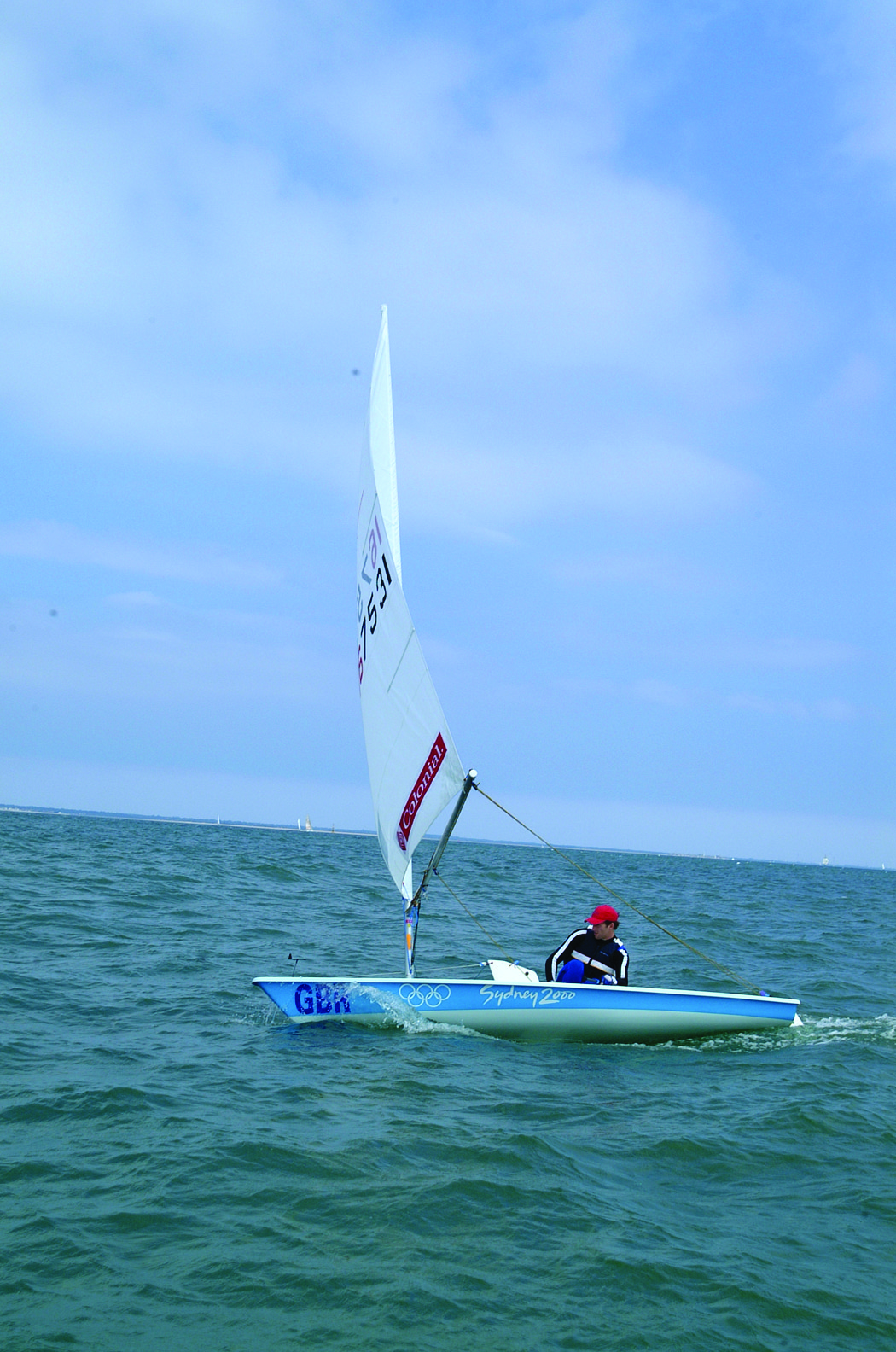
Cunningham off, van and outhaul loose
Cunningham
Right off.
Vang (Kicking Strap)
Loose! Pre-set it so the leech is nicely open most of the time. Too loose, and you lose too much power. The leech will constantly flick to squirt you forwards.
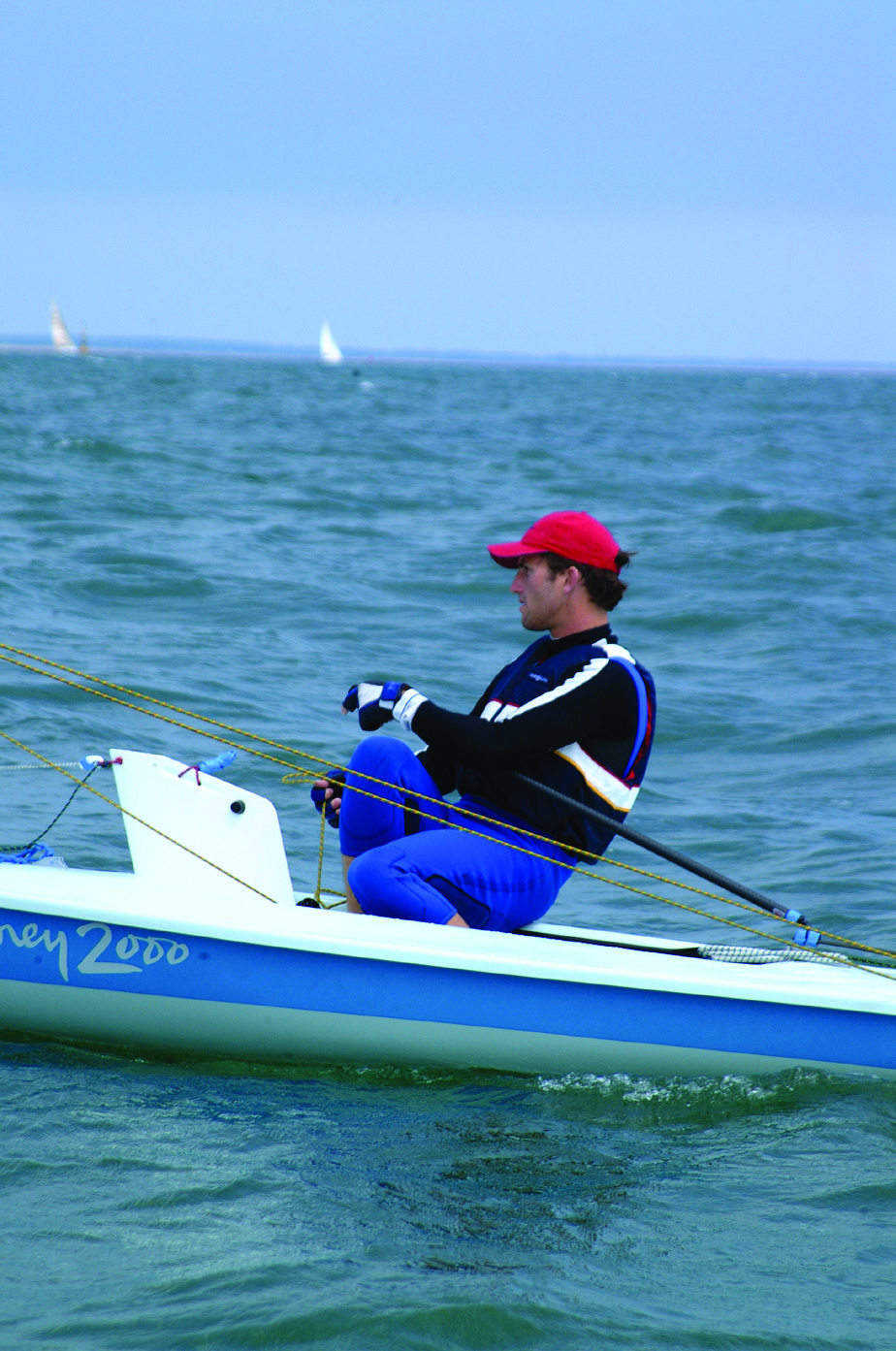
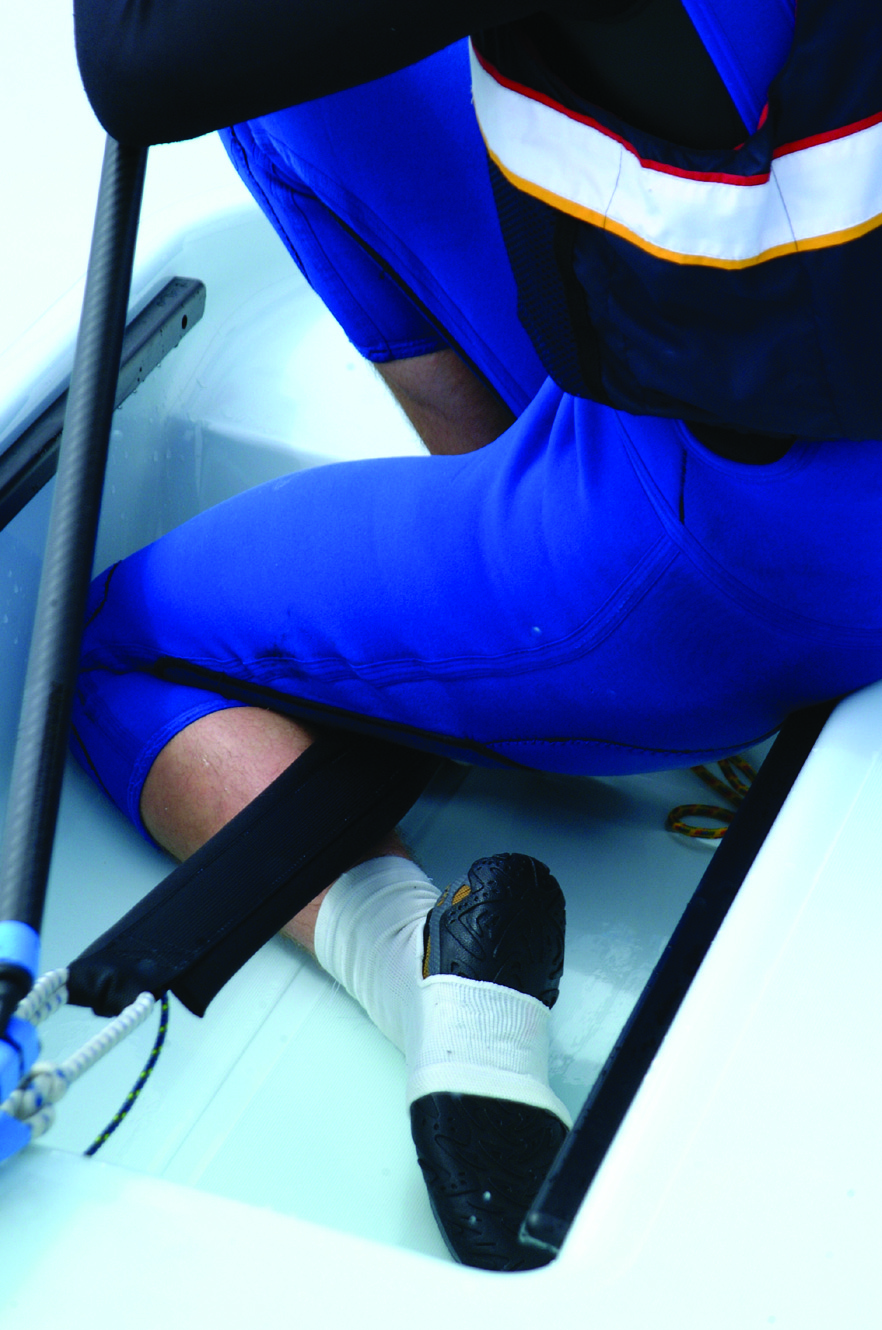
Running on starboard. My left foot stops me falling backwards when I bear away. I can push with my left knee when I want to luff. I use my front foot to lift up my body and to move my weight forwards and backwards.
Outhaul
Loose – all the way off.
Mainsheet
Sailing by the lee, just past 90°. Not too much, because with a loose leech the sail goes forward anyway. Sheet in quite a lot when you come up.
When making the turns, turn up at the right time, which is before you stop planing. Heeling the boat to leeward helps the turn. Turning the other way, roll the boat to windward to make it bear away.
Sit
I move my weight forwards and backwards but normally as far forwards as possible. Sometimes, when I’m trying to catch a wave my weight will be back, then I’ll push it really far forwards to help push the boat down the wave. Use your feet to stay in! I sit sideways, one foot locked up against my side of the cockpit. The other knee or foot is pressed against the leeward side of the cockpit for balance in the waves.
Gusts & Lulls
In the light spots you need to sail bigger angles to catch a wave and at some point you will realise you’re not going to catch any waves, so start thinking about pointing back at the mark again.
Unless you can catch waves, there’s no point in sailing extra distance.
The windier it gets the smaller the angles, because you have power in the sail anyway and you can ride the waves down to the buoy.
On form? Ask all the top sailors. Sometimes they can get in the groove and sometimes they just can’t find it. If you’re too tense, you must relax. Don’t try too hard.
If you zoom down a wave and head for the one in front you can either try to sail through it and hop onto the next one, which is really quick, or bear away or head up, depending on where the buoy is.
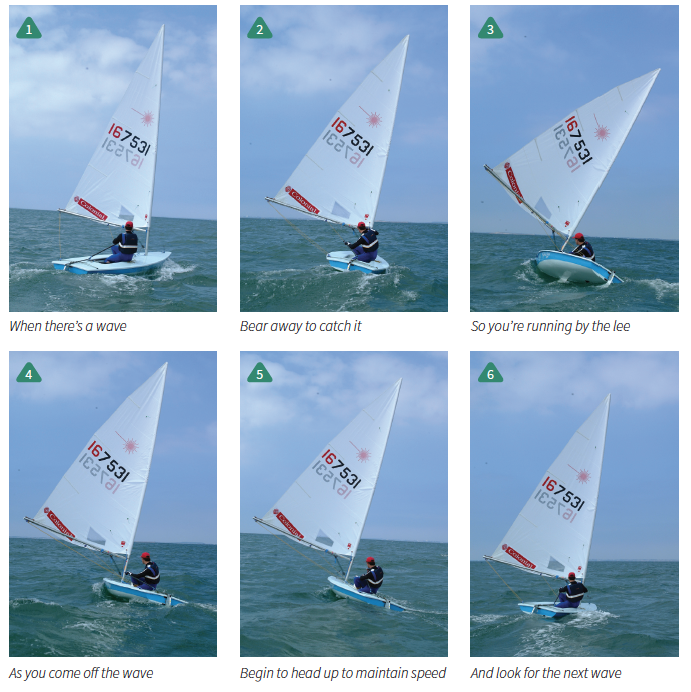
LIGHT WINDS
The trick is to sail the angles, but this time it is to keep the speed rather than looking for waves. If you can get your speed up then this will produce more apparent wind which you will be able to use to sail the boat lower but with more wind.
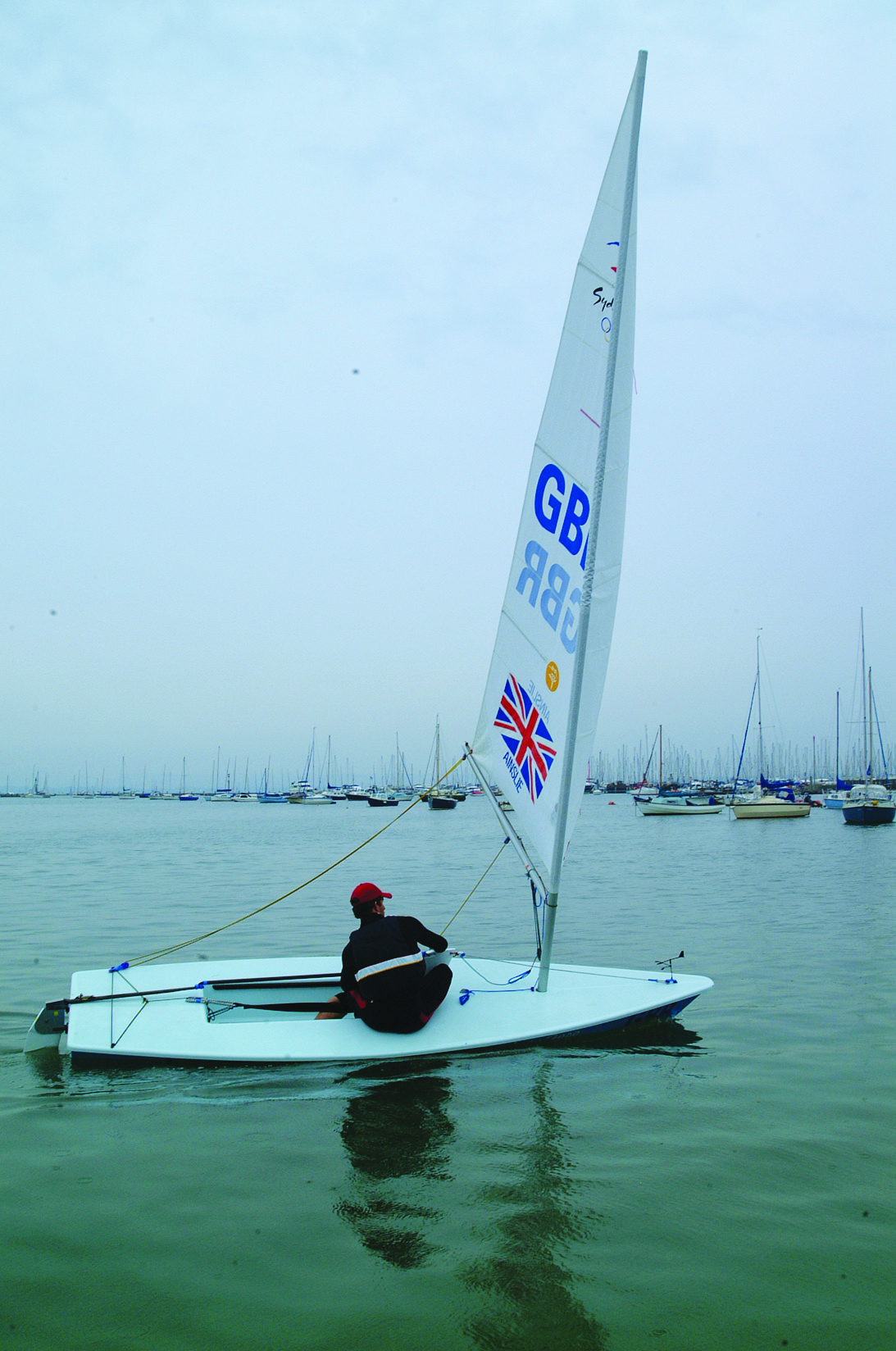
Running in light winds
Lasers also go very well in light airs when sailed by the lee. Sailing by the lee has two main benefits: it helps to keep the boom from falling into the middle of the boat in really light airs and it is also easier to tell if you are sailing a good angle to the wind.
If you are sailing by the lee too much then you will find you need to use a lot of helm to keep the boat on a steady course and so the best course is just off the angle when the rudder loads up.
In lighter airs I change my seating position to facing forwards with my back leg and calf under the toestrap for support and balance.
This position makes it much easier to heel the boat over to weather which is fast because you reduce the wetted surface area of the hull in the water and so reduce drag.
I also find that it is easier to trim the sail by taking the mainsheet straight from the boom rather than through the ratchet block. It reduces the friction and gives you a better feel for the wind in the sail.
The key to light airs is to be as smooth as possible – any jerky movements will spill the wind out of the sail and slow you down.
I developed a good technique in Sydney for really light air runs: I sat forward by the centreboard with my back leg in the cockpit and my forward leg stretched out against the vang. The forward leg holds the vang and stops the boom from coming into the middle of the boat when it loses the wind. It prevents all of those slow moments when you have to move forwards to push the boom out, which are effectively pushing the boat backwards.
Vang (Kicking Strap)
To its loosest setting. Onshore, go to the clew and flick the sail either side and if the leech is just opening, that’s the right vang setting. Adjust the rope at the bottom so this is the loosest setting.
When sailing return to this. The leech should just open if it gets some wind in it.
Centreboard
A bit higher. The further you run by the lee, the further down the centreboard should be.
Steer
Always try to sail by the lee and heel the boat to windward. As you feel the pressure coming on the sail, counter it by bringing your body weight in slightly which helps push the boat forward.
Mainsheet
About 90°, which is ideal. As the wind drops let it out further and sail more by the lee. Heel the boat to windward to reduce the wetted area, balance the helm and keep the sail out.
Sit
As far forward as possible. Front leg up against the centreboard and back leg wrapped under the toestrap for support.
Toestrap
Tight.
Gusts & Lulls
In a gust head more towards the mark. In a lull sail by the lee to keep the speed on. Look for the next gust coming down and sail over towards it.
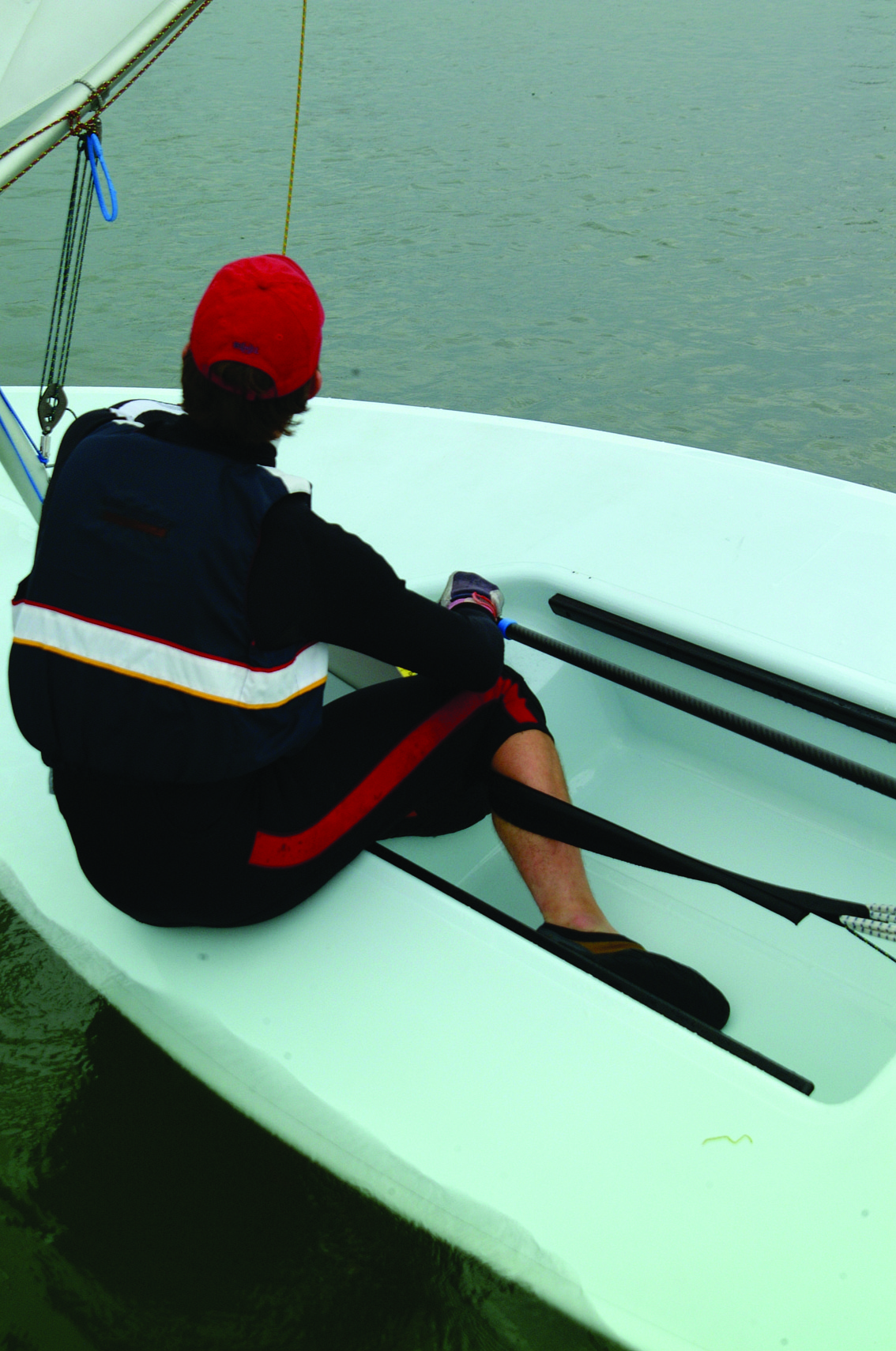
Sit as far forward as possible with the front leg up against the centreboard and the back leg wrapped under the toestrap
STRONG WINDS
Set everything as for medium winds – and then go for it!
The main difference from medium winds is that in strong winds you don’t have to head up as much to get the power in the sail, so you’re not sailing such big angles. If you catch a wave you can hold it longer and sometimes you can jump a wave, which is very fast.
You need an elastic loop to stop the vang falling out of the boom.
Try not to get too far off course. The most I’d ever do is three turns in one direction before making the turn in the other direction – e.g. three lefts then right. Very roughly, you’ll need to make a turn every 10 seconds, so 30 seconds in one direction.
If you find yourself rolling in to windward push the tiller away, sheet the sail in slightly and (if you have all your weight on your legs) move slowly into the cockpit. If the roll isn’t too dramatic you can sometimes use it to turn away and sail by the lee.
In Survival Conditions
In conditions over 20 knots it is often a case of just hanging on. Your weight should be as far back in the cockpit as possible to prevent nose-diving. It is often easier to steer by holding onto the tiller extension close to the joint and it also gives you a better feel for the rudder.
Lock your body into the boat by pressing your back knee up against the cockpit side with your front foot up against the front of the cockpit. The more secure you are the more control you will have.
Around 20 knots you should still be working the boat to get the best out of it as there are still big gains to be made against people who are just sailing safely. Keep working the waves and the fastest angle to the wind.
As the breeze gets over 25 knots the fastest course is often straight to the mark as the boat will plane dead downwind. The safest course is either to sail slightly by the lee or on a broad reach, but then you are obviously sailing a greater distance. It is definitely a case of trial and error but the more you practise it the better you will be.
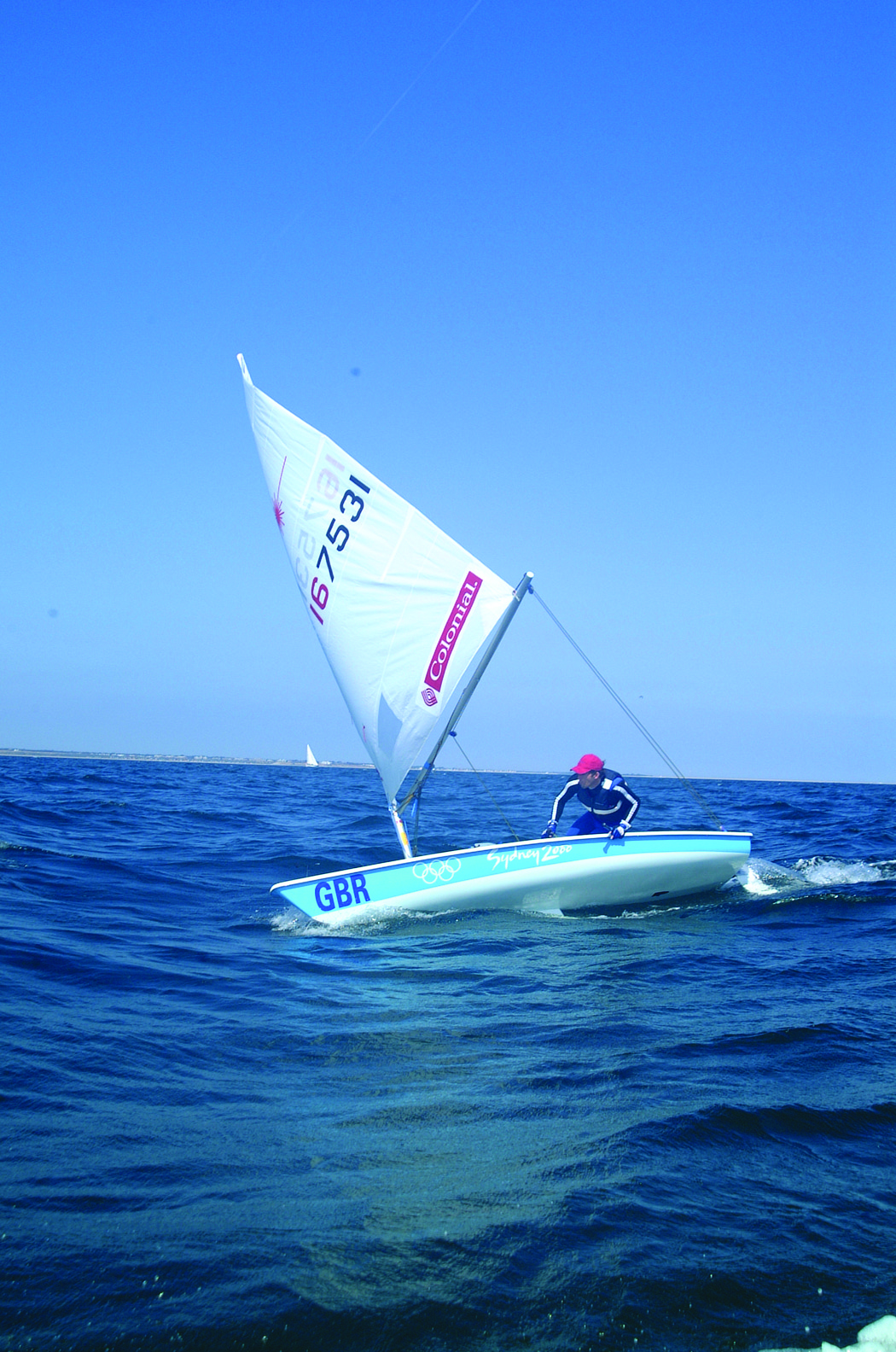
If you start rolling in to windward, push the tiller away and sheet in slightly; be careful not to pull your weight in too hard or you will push the weather deck down and swim
© Not to be reproduced without written permission from Fernhurst Books Limited.
The Laser Campaign Manual is written by the world’s most successful Olympic sailor and is the book he wrote after winning his first gold medal. Sir Ben Ainslie’s Laser Campaign Manual was re-published in 2020 as a special 20th Anniversary edition of winning that gold in the Laser in Sydney.